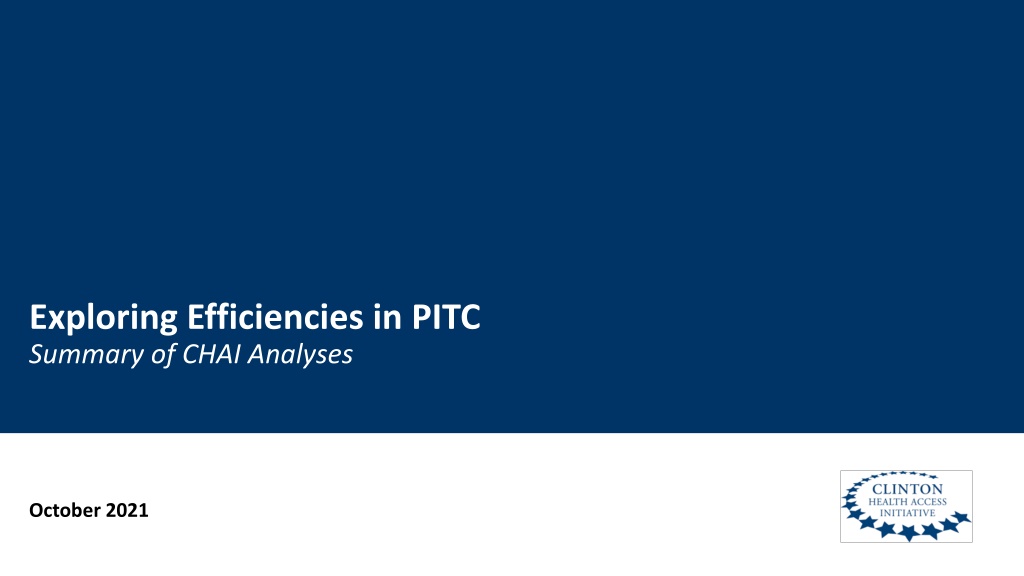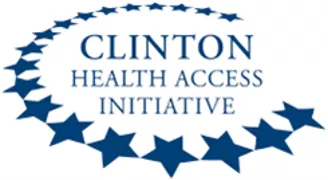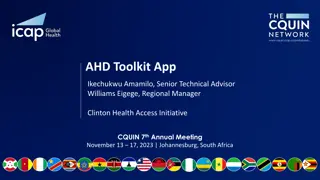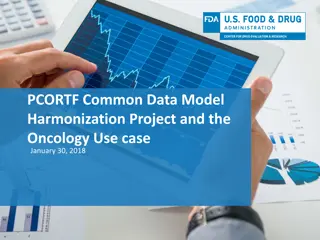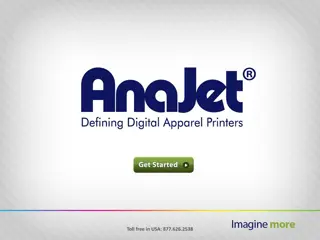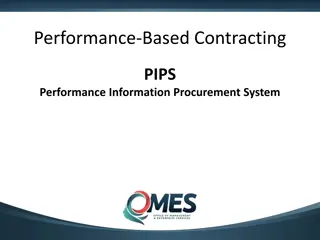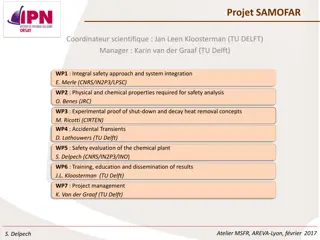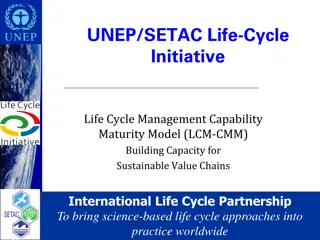Efficiencies in PITC: CHAI's Analysis and Strategies
CHAI is working with Ministries and partners to enhance testing efficiency by identifying and scaling more targeted models. They are exploring various strategies such as index testing, facility-based testing, and HIV self-testing to reach priority populations effectively while reducing burden on the health system and clients. Evaluations of risk-based screening tools in Uganda have highlighted challenges in terms of sensitivity, specificity, and time burden on healthcare workers.
Download Presentation

Please find below an Image/Link to download the presentation.
The content on the website is provided AS IS for your information and personal use only. It may not be sold, licensed, or shared on other websites without obtaining consent from the author.If you encounter any issues during the download, it is possible that the publisher has removed the file from their server.
You are allowed to download the files provided on this website for personal or commercial use, subject to the condition that they are used lawfully. All files are the property of their respective owners.
The content on the website is provided AS IS for your information and personal use only. It may not be sold, licensed, or shared on other websites without obtaining consent from the author.
E N D
Presentation Transcript
Exploring Efficiencies in PITC Summary of CHAI Analyses October 2021
CHAI is supporting Ministries and partners to Identify and scale more efficient models of testing Over the last few years there has been a push across countries to make testing more targeted Implementation experience over this period has highlighted some new learnings and challenges Efforts to reduce volumes and increase yield rates within facilities, including through implementing screening tools While screening tools can increase testing yield, they also screen out PLHIV and can be HCW time intensive to implement Highly targeted modalities such as index testing should be maximized, but also resource intensive and inherently limited in reach Shifting investment towards the scale-up of highly targeted strategies like index testing Facility based testing has key advantages- large population reach, captive audience, linkage facilitation- but current model of care not optimized for health system and clients Scale-up of innovative strategies like HIV self- testing to identify PLHIV not previously accessing testing services How can we best target priority populations in a way that leverages the benefits of facility-based testing while reducing the burden on the health system and clients? 2
Evaluating risk based screening tools: The time required to screen combined with the typically low sensitivity and specificity of these tools, often results in a high burden on HCW time and reduced number of PLHIV identified Client Pathway with Risk-Based Screening Tool Implemented based off implementation in Uganda Outpatientdepartment (OPD) HIV testing point Health education sessions Risk determination and referral Screening Professional-Use Testing Pre-test messages provided to all clients, briefly describing the screening process. Administered to clients one-on-one, either at triage or in the clinical room. Being integrated with TB screening. Healthcare worker refers eligible clients to HIV testing or prevention services, as appropriate. Eligible clients tested and linked to treatment or prevention. Low specificity means many HIV-negative clients are still screened in x Require 5-8 minutes to screen and document each client Low sensitivity means PLHIV will be screened out 3
Evaluating risk based screening tools: An evaluation of a risk-based screening tool in Uganda found that screening did not significantly increase yield rate and would miss nearly 10% of PLHIV Analysis modeled the potential impact of scaling screening nationally in OPD, based on the sensitivity of the screening tool, current facility testing volumes, and HR and commodity costs in Uganda. Screening could reduce the number of A1 tests by 2.2 million, with cost savings of approximately $1.5 million (~6%) Costing accounted for HR and commodities Does not reflect the full costs of implementing screening (training, printing and dissemination of tools, M&E, etc.) Evaluation of Uganda national screening tool 2019 20,000 4,832 Screening reduced testing by 24.5% but 9.3% of PLHIV were missed by screening 15,000 10,000 14,885 68 5,000 If scaled nationally 22,131 PLHIV would be screened out in OPD There are significant costs to missing PLHIV, delaying diagnoses and initiation onto treatment PLHIV screened out at the facility will likely need to be identified through other strategies that are more expensive than facility-based testing 664 0 Number Tested PLHIV Eligible Ineligible Yield rate increased from 3.71% to 4.46%, but this change was not statistically significant. 4
Exploring other methods of driving efficiencies within facilities: Evidence indicates that HIVST could be used as a highly sensitive screening tool (A0) at OPD to increase testing coverage and generate efficiencies 1 The survey found that, contrary to popular belief, under-reached populations visit facilities, but are not regularly offered HTS In collaboration, PIH and CHAI sought to examine under- reached populations use of facility-based health services. Reaching Priority Populations Even though 80% of those youth and men reported attending a health facility in the last two years 42% of youths and men surveyed had either never been tested or had not tested in the last two years 2 HIVST lead to a 3x increase in overall testing uptake among priority populations, including men & young people Standard provider-initiated testing and counselling Optimised provider-initiated testing and counselling Facility-based HIV self-testing PIH s initial study found that HIVST in facilities is acceptable, increases testing uptake, results in similar positivity rates to standard HTS, and increases new identifications. HIV testing coverage by sex and age across trial groups (n=5,885) Testing Uptake 3x 3 BothHIVST arms required significantly less HCW time than provider- initiated testing and counseling Percentage time saved/gained per test completed, per arm PIH recently conducted a second study on HIVST distribution in facilities, which had a secondary outcome focused on HCW time required per test completed. Program Efficiency PITC +11% Passive HIVST -36% -53% Active HIVST Source: Dovel, K, Shaba, F, et. al. Effect of facility-based HIV self-testing on uptake of testing among outpatients in Malawi: cluster randomized control trail, Lancet Global Health. 2020; Dovel, Balakasi, et al. Missing men or missed opportunity? Men s frequent use of health services in Malawi. IAS. 2020 *Active HIVST differed from Passive HIVST in that providers initiated the distribution of HIVST 1:1 in a private area, not in a group.
In 2019, CHAI and Partners in Hope conducted a survey, which found that priority populations do visit health facilities, but are not always offered HIV testing; signaling an opportunity to further optimize facility testing 1 A study conducted by Partners in Hope (PIH) in Malawi, which sought to examine under-reached populations use of facility-based health services over the past four years, found that under-reached populations, specifically men and young people, do visit facilities as both clients and guardians, but are not being offered HTS. Community Survey Findings 100% Percent of those who have not tested in the last 24 months who are offered testing 90% 80% 70% 60% 42% of youth and men who were surveyed were in need of testing (i.e., had never been tested or had not tested in the last two years) 50% 40% 24.2% 23.3% 30% 14.7% 20% 11.6% 11.5% 4.4% 10% 0% Guardian Client Guardian Client Guardian Client Young women (15-24 years) Young men (15-24 years) Men (25+ years) Only 5-24% of people who had not tested in the last two years and who visited a facility as a client or guardian were offered testing 80% of those in need of testing attended a health facility in the last two years 6 Source: Preliminary findings from the Scaling Facility HIV Self-Testing study, Dovel K, et. al. 2019
PIH had separately conducted a study in Malawi, which found that distribution of HIVST at OPD increased testing uptake among priority populations and improved linkage to care, as compared to community HIVST 2 Results HIV testing coverage by sex and age across trial groups (n=5,885) HIVST offered in facilities is acceptable 60% 50% HIV Testing Coverage Results in similar positivity rates to standard PITC 40% 3x 30% Can lead to a 3x increase in overall testing uptake (see figure)among priority populations, including men and young people 20% 10% 0% Higher linkage to care than community-based HIVST distribution All Male Adult ( 25 years) Female Adult ( 25 years) Adolescent (15-24 years) Standard of Care: Provider Initated Testing and Counselling Facility-based HIV Self-Testing Source: Dovel, K., Shaba, F., Offorjebe, O. A., Balakasi, K., Nyirenda, M., Phiri, K., ... & Cele, R. (2020). Effect of facility-based HIV self-testing on uptake of testing among outpatients in Malawi: a cluster-randomised trial. The Lancet Global Health, 8(2), e276-e287; Ortblad K, et al. PLoS Med 2017; MacPherson P, et al JAMA 2014; 312: 372 79., Sibanda E, et al. CROI 2018 7
CHAI collaborated with PIH for a follow-up study in Malawi, which confirmed that offering HIVST to clients at OPD increased rates of testing and found that it reduced health provider time per test completed by 53% 3 Implementation of Active HIVST In 2020, Partners in Hope implemented facility-based HIVST at OPD in 3 facilities in Malawi. Total Health Care Worker Time per Test Completed 60 A provider demonstrated how to use an oral HIVST kit during the health talk and clients who were interested in HIVST were confirmed as eligible (i.e., never tested positive, never tested or tested more than 12 months ago). 50 -53% HCW time could be reallocated toward other priority activities 40 Minutes All activities took place prior to routine OPD services and were implemented by cadres with no more than a secondary school certificate. 30 20 Pre- Post- Outcomes Implementation Implementation 10 Same-day testing, among those in need of testing 7% 26% 0 Active HIVST New HIV-positives, among those tested (Yield) 0 8% Pre-Implementation Same-day ART initiations, among new positives N/A 88% Post-Implementation
CHAI developed a model to estimate costs, time requirements, and PLHIV identified across three testing approaches Modeling Question: Could using HIVST as a screening tool be more cost effective and efficient than risk-based paper screening tools in identifying people in need of professional-use HIV testing? Model Structure Scope: Analyzes a hypothetical population of 1,000,000 adults who would be tested for HIV at OPD. The model does not account for any increase in testing uptake due to either a wider pool of clients being screened or introduction of HIVST. Scenarios: HIVST as an A0 Risk-Based Screening Providers individually screen each client using a risk-based tool Current Testing Approach PITC for every client All clients are screened using an HIVST and those with a reactive test are tested by a provider Outcomes: # of PLHIV Identified # of A1 Tests Conducted # of Overall Tests Conducted # of HCW Hours Required for Testing Commodity Costs Labor Costs *Studies on HIVST implementation in facilities have demonstrated an increase in overall testing volumes due to the introduction of HIVST (Dovel, K.). Depending on whether a risk-based screening tool is applied to all clients entering OPD, it could also lead to an overall testing uptake. 9
The model is based on data generated through the Ugandan Ministry of Health Screening Tool Evaluation and from PIH s implementation studies on facility-based HIVST in Malawi Model Assumptions Current Testing Approach Risk-Based Screening HIVST as Screening Tool % of Clients Screened N/A 100% 100% % of Clients Screened-In for an A1 Test 100% 75% 3.71% 3.71% 4.46% 95.01% % of Clients Testing Positive at A1 (Baselined yield in Uganda screening tool eval) (Yield for those screening in in Uganda screening tool eval) (Calculated from baseline yield and sens/spec of OraQuick and Determine) Group health talk with pre-test information (7 min per group) Professional-use testing for those screened in Individual post-test counseling (5 min per negative/10 min per positive) Time Required Group demonstration & distribution of kits (+11.5 min per group) Individual support/assistance to clients (+2 min per person) Delivery & documentation of screening questions (+5 min per person) Ugandan MoH Screening Tool Evaluation Preliminary PIH Data on Facility-Based HIVST CHAI Uganda Team Sources 10
Using HIVST as an A0 in OPD at facilities could identify 9% more PLHIV than using a risk-based paper screening tool while reducing healthcare worker time spent on testing by 82% Number of PLHIV Identified by Testing Approach Total Number of A1 Tests Required by Testing Approach Total Hours Required by Testing Approach 1.2M 40K 400K 37,125 36,791 348K 345K 1 M 350K 9.25% fewer PLHIV 33,677 35K 1.0M 300K 25% reduction 30K 755K 800K 250K 25K 82% reduction 600K 200K 20K 96% reduction 150K 400K 15K 100K 62K 10K 200K 50K 39K 5K K K K Current Testing Process Risk-Based Screening HIVST as an A0 Current Testing Process Risk-Based Screening HIVST as an A0 Current Testing Process Risk-Based Screening HIVST as an A0 The major driver of the HCW time savings is a 96% decrease in number of A1 tests required as only those that screen A0- positive would be referred for professional-use testing Implementing any sort of screening within the existing testing population will reduce the number of PLHIV identified, as no tool will be 100% sensitive Using HIVST as an A0 would decrease the total amount of HCW time required for testing by 82%. 11
Using HIVST as an A0 in OPD at facilities could identify 9% more PLHIV than using a risk-based paper screening tool while reducing healthcare worker time spent on testing by 82% Number of PLHIV Identified by Testing Approach Total Number of A1 Tests Required by Testing Approach Total Hours Required by Testing Approach Increasing screening coverage could increase PLHIV identified, but would require more time than it would take to just test all clients 1.2M 40K 400K 37,125 36,791 348K 345K x 1 M 350K 9.25% fewer PLHIV 33,677 35K 1.0M 300K 25% reduction 30K 755K 800K 250K The time saved by screening out 25% of people is offset 25K 82% reduction 600K 200K by the time required to 20K 96% reduction Screening with HIVST could be increased many fold while still saving HCW time 150K screen each person 400K 15K 100K 62K 10K 200K 50K 39K 5K K K K Current Testing Process Risk-Based Screening HIVST as an A0 Current Testing Process Risk-Based Screening HIVST as an A0 Current Testing Process Risk-Based Screening HIVST as an A0 The major driver of the HCW time savings is a 96% decrease in number of A1 tests required as only those that screen A0- positive would be referred for professional-use testing Implementing any sort of screening within the existing testing population will reduce the number of PLHIV identified, as no tool will be 100% sensitive Using HIVST as an A0 would decrease the total amount of HCW time required for testing by 82% 12
As the price of HIVSTs decrease, costs per person tested and cost per PLHIV identified will be comparable to and eventually lower than current PITC and using risk-based screening tools Combined Labor and Commodity Costs per Person Screened and Tested Cost per PLHIV Identified $70 $59 $2.50 $60 $2.17 $45 $50 $1.31- $1.45* $2.00 $39-43* $1.67 $42 $1.55 $40 $1.50 $32 $1.17 $30 $1.00 $20 $0.50 $10 $- $- Current Testing Process Risk-Based Screening HIVST as an A0 at $2 per test HIVST as an A0 at $1.50 per test HIVST as an A0 at $1 per test Current Testing Process Risk-Based Screening HIVST as an A0 at $2 per test HIVST as an A0 at $1.50 per test HIVST as an A0 at $1 per test Labor Costs per Person Commodity Costs per Person In the HIVST scenarios, the main cost driver is the cost of HIVST products At a slightly reduced price of $1.50 per kit, the total cost per person would be comparable to the current testing approach At a $1 price per HIVST kit, using HIVST as an A0 would cost 24% less than universal PITC and 18-25% less than risk-based screening approaches 13 *Low-end cost range for risk-based screening represents estimated costs where screening tool takes 5 min to administer, high-end range represents costs where screening tool takes 10 min to administer
Expanded use of HIVST as a screening tool within facilities could expand testing coverage to priority populations, reduce HCW time spent on testing, and generate cost-savings Benefits of HIVST as a facility-based screening tool: Highly sensitive and specific Increased testing coverage and uptake among priority populations Significant reduction in HR capacity required for testing compared to current PITC and risk-based screening Many HTS providers already trained on HIVST distribution In the context of COVID, reduces direct HCW-patient contact and can help decongest facilities while maintaining HTS delivery Introduction of lower-priced HIVST products will generate cost-savings 1 4
